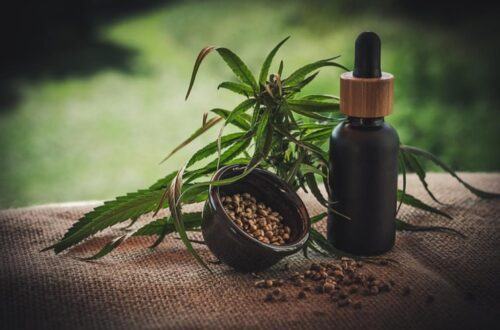You’ve probably heard a lot about CBD lately—it’s all the rage. But did you know it’s not just for humans?
Many pet owners are curious about how this natural compound can benefit their furry friends. From alleviating anxiety to reducing pain, CBD seems to be a wonder solution for our pets’ issues.
But how does it really work? And is it safe?
In this post, we’ll dive into the science behind CBD and explore its potential effects on animals, providing you with the information you need to make informed decisions about your pet’s health.
Ready to unlock the mysteries of CBD for animals? Let’s get started!
The Endocannabinoid System in Animals
Let’s start with a fascinating fact: animals have an endocannabinoid system (ECS) just like humans. This system plays a vital role in maintaining homeostasis, or balance, within the body.
The ECS is made up of receptors, enzymes, and endocannabinoids. These components work together to regulate various bodily functions such as mood, appetite, pain, and immune response.
There are two main types of receptors in the ECS: CB1 and CB2. CB1 receptors are primarily found in the brain and central nervous system, while CB2 receptors are located in the peripheral organs and immune cells.
When CBD is introduced into an animal’s system, it interacts with these receptors to create various effects. It doesn’t bind directly to them but rather influences how the body naturally produces and uses its own endocannabinoids.
This interaction is why CBD can help with issues like stress, pain, and inflammation. Each animal’s ECS is unique, so the effects can vary depending on the individual pet.
Understanding the ECS is the first step in appreciating how CBD can benefit our four-legged friends. Got it? Great! Now let’s move on to how CBD can specifically help your pets.

Potential Benefits of CBD for Animals
Now that we’ve covered the basics of the endocannabinoid system in animals, let’s dive into the potential benefits of CBD for our furry friends.
First on the list is stress and anxiety relief. Just like humans, animals can experience anxiety from various sources like loud noises, separation, or unfamiliar environments. CBD has calming properties that can help reduce anxiety and promote a sense of well-being.
Next, let’s talk about pain management. Whether it’s due to aging, injury, or chronic conditions like arthritis, pain can severely impact an animal’s quality of life. CBD has anti-inflammatory properties that can help alleviate pain and improve mobility.
Inflammation isn’t just about pain, though. It can also affect skin conditions. Some pet owners have found that CBD helps with issues like hot spots, itching, and allergies, leading to healthier skin and coats.
Epilepsy and seizures are another area where CBD shows promise. For animals that suffer from these conditions, CBD can potentially reduce the frequency and severity of seizures, providing much-needed relief.
Additionally, CBD can support overall wellness. It can boost appetite in animals that are underweight or recovering from illness and can also promote better sleep, contributing to a happier, healthier pet.
Remember, while many pet owners have seen these benefits, it’s crucial to consult with a veterinarian before introducing CBD into your pet’s routine. Each pet is unique, and a professional can help ensure the best possible outcome for your furry friend.
How to Administer CBD to Pets
Once you’ve decided to try CBD for your pet, the next question is, how exactly do you give it to them? Fortunately, there are several easy ways to administer CBD, making the process stress-free for both you and your furry friend.
CBD Oil and Tinctures
One of the most popular methods is using CBD oil or tinctures. These come with a dropper, allowing you to measure the exact dosage your pet needs. You can place the oil directly into their mouth, ideally under their tongue for faster absorption. If your pet isn’t too fond of this idea, you can mix the oil into their food or water.
CBD Treats
Another convenient option is CBD-infused treats. These are just like regular pet treats but with the added benefits of CBD. They are pre-measured, so you don’t have to worry about getting the dosage right. Plus, pets usually love them, making it an enjoyable experience.
CBD Capsules
For those who prefer a more controlled approach, CBD capsules are a great choice. You can easily hide them in a piece of cheese or a treat, and they provide a consistent dose every time. Capsules can be particularly handy if your pet is very picky about their food.
Topical CBD
If your pet has localized issues like skin irritations or joint pain, topical CBD products can be very effective. These come in balms, salves, or creams that you can apply directly to the affected area. This method ensures that the CBD goes directly where it’s needed most.
Whichever method you choose, it’s important to start with a low dose and gradually increase it while monitoring your pet’s response. Always follow the guidelines provided by your veterinarian to ensure you’re giving the correct dosage.
Administering CBD to pets can be simple and even enjoyable, leading to a happier, healthier life for your furry family members.
Understanding CBD Dosage for Different Animals
Determining the right CBD dosage for your pet can be a bit tricky since different animals and breeds may react differently. However, there are some general guidelines you can follow to make the process easier.
First, it’s essential to consider your pet’s size and weight. Smaller animals, like cats or small dogs, will require a lower dosage compared to larger breeds. As a general rule of thumb, start with 0.2mg of CBD per pound of body weight. For example, if your dog weighs 30 pounds, you would begin with a dosage of 6mg of CBD.
Next, observe your pet’s reaction to the initial dose. Watch for any positive or adverse effects. If you notice improvement in their condition without any negative side effects, you’ve likely found a suitable starting dose. On the other hand, some pets may require a bit more or less, so be prepared to adjust accordingly.
Also, understand that the potency of CBD products can vary. Check the label to ensure you know how much CBD is in each drop, treat, or capsule. This will help you to precisely measure and control the dosage.
Remember, it’s crucial to administer CBD consistently. Whether it’s once or twice a day, keeping a regular schedule will help in maintaining the levels in your pet’s system and monitoring their progress more effectively.
Lastly, always consult with your veterinarian before starting CBD. They can provide personalized advice and ensure that CBD won’t interact with any medications your pet may be taking. With a little patience and careful observation, you’ll find the right dosage to help your furry friend thrive.
Conclusion: Best Practices for Using CBD with Animals
In wrapping up, it’s evident that CBD can offer a range of benefits for animals, from reducing anxiety to relieving chronic pain. However, to ensure the best results and safety for your furry friends, there are a few key practices to follow.
First and foremost, always consult your veterinarian before introducing CBD into your pet’s routine. Vets can provide valuable insights and help you avoid any potential side effects, especially if your pet is on other medications.
Starting with a low dose and observing your pet’s reactions is crucial. This cautious approach helps you find the appropriate dosage while minimizing the risk of adverse effects. Remember, each animal is unique, and what works for one may not work for another.
Consistency is another critical factor. Administering CBD regularly and at the same times each day will help maintain its benefits. Tracking your pet’s behavior, mood, and any signs of improvement can provide valuable feedback for adjustments.
Quality matters. Always opt for high-quality CBD products that are specifically designed for animals. Look for third-party lab-tested options to ensure you’re giving your pet a safe and effective product.
Lastly, patience and attentiveness are essential. Changes might not happen overnight, so give your pet some time to adjust and keep a close eye on their progress. Being observant will help you identify what works best for them and make any necessary tweaks.
By following these best practices, you can confidently incorporate CBD into your pet’s care routine, offering them a natural way to improve their overall well-being. Your furry friends deserve the best, and with careful planning and love, you can help them lead happier, healthier lives.






